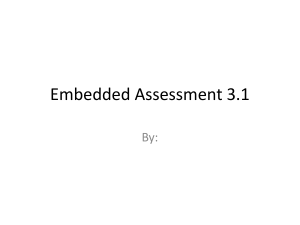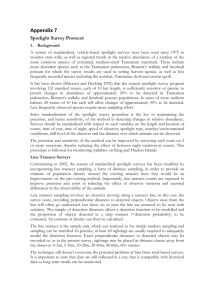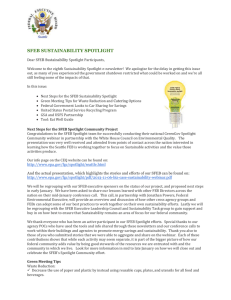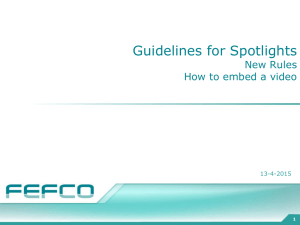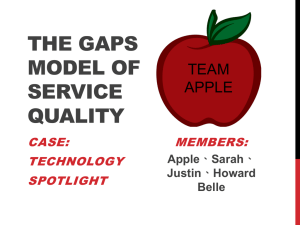Spotlighting protocol - Department of the Environment
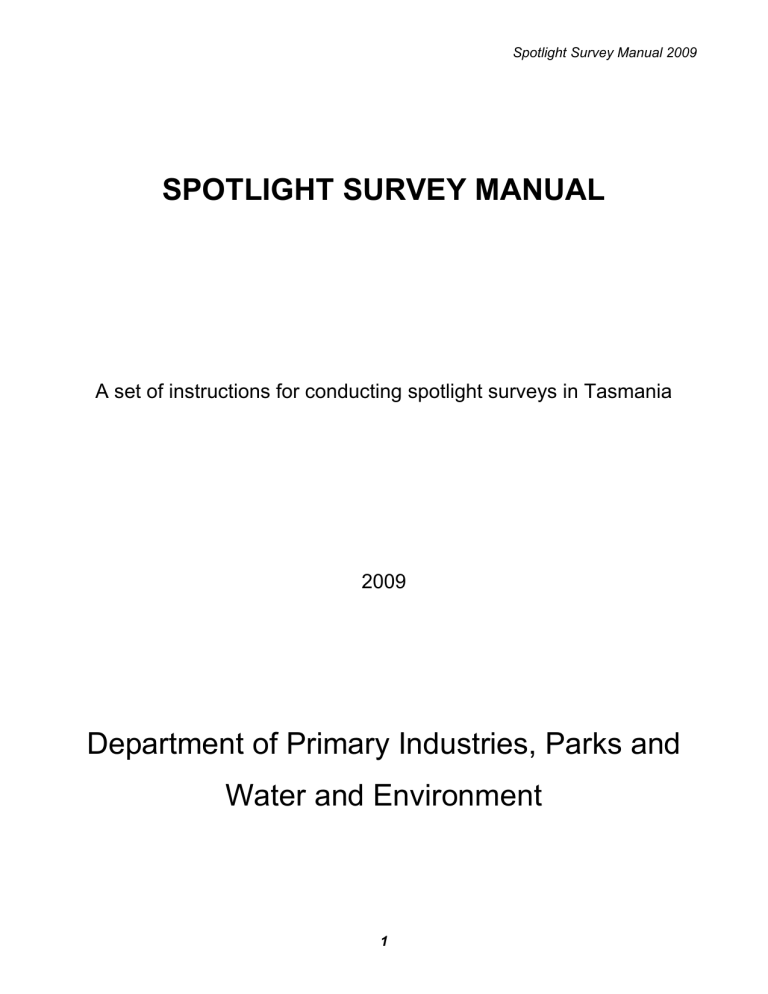
Spotlight Survey Manual 2009
SPOTLIGHT SURVEY MANUAL
A set of instructions for conducting spotlight surveys in Tasmania
2009
Department of Primary Industries, Parks and
Water and Environment
1
Spotlight Survey Manual 2009
SUMMARY
1. This manual provides a set of instructions for conducting spotlight surveys
2. Spotlighting should be undertaken using a roof mounted 100 W sealed beam spotlight on a vehicle in which the observer’s head is approximately 1.6m above ground level. The vehicle should travel at 20 km/h.
3. Surveys should be conducted between the third week of November and the end of December.
4. Surveys should commence 40 minutes after sunset.
5. Surveys should not be conducted during high winds, rain or fog.
6. In a change from previous years, the driver does not spotlight, only the passenger may spotlight and count animals, the driver is only responsibility is safely drive the vehicle.
7. Survey routes should be surveyed by the same observer each year.
8. All new observers should be appropriately trained in the spotlight survey method.
9. All non-domestic mammals and nocturnal birds should be recorded.
10. Weather conditions, moon phase, and traffic volume should be recorded.
2
SUMMARY
1. INTRODUCTION
2. EQUIPMENT
2.1 Type of Vehicle
2.2
2.3
Type of Spotlight
Recording Sheets
3. OBSERVERS
3.1
3.2
Number
Training
3.3 Continuity
4. SPOTLIGHTING METHOD
4.1 Use of Spotlight
4.2 Speed of Surveying
4.3 Animals to be Counted
4.4 Timing
5. WEATHER AND MOON PHASE
5.1 Unfavourable Conditions
5.2 Recording Weather and Moon Phase
6. TRAFFIC VOLUME
7. ON ROAD/OFF ROAD
8. RECORDING CHANGES IN CONDITION OF ROUTES
9. NOTIFICATION OF LOCAL AUTHORITIES
10. DESCRIPTION AND MAPS OF SURVEY ROUTES
3
Spotlight Survey Manual 2009
Spotlight Survey Manual 2009
1. INTRODUCTION
The spotlight survey method has been used to monitor the abundance of Tasmanian mammals since 1975. Although the survey was originally set up to monitor those species subject to culling, in practice all non-domestic species are recorded. Over the last sixteen years the method has gone through a process of modification with the most significant changes occurring in 1985 following a major review. This review recommended a trebling of the number of routes and strict standardization of the procedure to ensure that trends in survey counts were a better reflection of actual changes in the population. The value of strict standardization of the procedure cannot be stressed enough as any variation may invalidate the counts.
This manual specifies the standard procedures to be followed in conducting spotlight surveys and contains descriptions and maps of the survey routes.
2. EQUIPMENT
2.1 Type of Vehicle
Some vehicles are better suited to spotlighting than others. Only vehicles in which a seated obse rver’s head is approximately 1.6 m above ground level should be used.
2.2 Type of Spotlight
It is important that the same type of spotlight be used by all observers as differences in the strength of the beam can result in different numbers of animals being counted. A roof mounted
‘Lightforce’, 100 W, 12 V sealed beam spotlight is the standard spotlight used. The spotlight is operated from within the cab by the passenger via a handle attachment.
2.3 Recording Sheets
An example of a spotlight survey data sheet is included as an appendix to this manual. One sheet is completed for each route surveyed.
4
Spotlight Survey Manual 2009
3. OBSERVERS
3.1 Number
Only one person may spotlight and count animals, and that person must be the passenger.
Assistants may be used to record information, but must not assist in counting animals as this will lead to inflated counts.
3.2 Training
All new observers should be trained by experienced observers. This training should consist of several nights in which the trainee accompanies the experienced observer, followed by several nights in which the trainee conducts the surveys under supervision. The trainee must be confident of identifying all potentially recordable species. Training should include identification of species using eye-shine and movement characteristics.
3.3 Continuity
Observers will vary their ability to count animals on spotlight surveys. In order to reduce the effect of this variability, routes should be surveyed by the same observer each year.
4. SPOTLIGHTING METHOD
4.1 Use of Spotlight
Spotlighting is to be undertaken by the driver. The roof-mounted spotlight is to be operated with the left hand with the arm resting on the open window. The beam is continuously swung in a 180
arc in front of the car. Spotlighting should mainly be directed at ground level. DO NOT spotlight on houses.
4.2 Speed of Surveying
Vehicle speed should be maintained at 20 km/h thereby allowing one 10 km survey route to be traversed in half an hour. In fields where animals are numerous it may be necessary to stop and count.
5
Spotlight Survey Manual 2009
4.3 Animals to be Counted
All non-domestic mammals should be counted. A list of the most commonly recorded species is given below. Bats and rodents may be noted, but species identification may be difficult. All cats seen should be counted, regardless of whether they are domestic or feral. In addition, three nocturnal bird species should also be recorded: the Tawny Frogmouth, Southern Boobook, and Masked Owl.
Macropods
Eastern grey (forester) kangaroo
Bennett’s wallaby
Tasmanian pademelon
Tasmanian bettong
Long-nosed potoroo
Possums
Brushtail possum
Ringtail possum
Introduced Species
Feral/domestic cat
European rabbit
Brown hare
Dasyurids (Carnivores)
Tasmanian devil
Spotted-tailed quoll (tiger cat)
Eastern quoll
Bandicoots
Eastern barred (striped) bandicoot
Southern brown bandicoot
Other Native Species
Common wombat
Echidna
Birds
Tawny frogmouth
Southern boobook
Masked owl Fallow deer
4.4 Timing
4.4.1 Time of Night
Animals vary in their activity during the course of a night. For example, many Tasmanian mammals come out to feed for a short period after dusk, then retreat to their nests and then come out again later. It is therefore important that the starting time for a particular route be standardized from year to year. In order to achieve this, spotlight surveys must start approximately 40 minutes after sunset, and routes done on the same night must be done in the same order year after year. A list of start times for November 15 to January 31 is given in Table 1. On cloudy nights it may be possible to start up to ten minutes earlier.
6
25
26
27
28
21
22
23
24
29
30
15
16
17
18
19
20
Spotlight Survey Manual 2009
Table 1.
Approximate starting dates and times for spotlight surveys. All times given in EST (PM).
Date
November
Time Date
December
Time
1
2
3
4
5
6
7
8
9
9:12
9:13
9:14
9:15
9:16
9:17
9:18
9:19
9:20
Date
1
2
3
4
5
6
7
8
9
January
Time
9:32
9:33
9:33
9:33
9:32
9:32
9:32
9:32
9:32
8:52
8:54
8:55
8:56
8:57
8:59
10
11
12
13
14
15
16
17
18
19
20
9:21
9:22
9:23
9:24
9:24
9:25
9:26
9:27
9:27
9:28
9:28
10
11
12
13
14
15
16
17
18
19
20
9:32
9:31
9:31
9:30
9:30
9:30
9:29
9:29
9:28
9:27
9:27
9:00
9:01
9:02
9:04
9:05
9:06
9:07
9:08
9:10
9:11
25
26
27
28
21
22
23
24
29
30
31
9:29
9:29
9:30
9:30
9:31
9:31
9:31
9:32
9:32
9:32
9:32
25
26
27
28
21
22
23
24
29
30
31
9:26
9:25
9:24
9:24
9:23
9:22
9:21
9:20
9:19
9:18
9:17
7
Spotlight Survey Manual 2009
4.4.2 Time of Year
It is of vital importance that spotlight surveys be conducted over as short a time as possible to avoid natural changes in composition of animal populations due to recruitment and mortality. For this reason, spotlight surveys must not commence before the third week of November and should be completed by the end of December.
5. WEATHER AND MOON PHASE
5.1 Unfavourable Weather Conditions
Certain weather conditions, such as high winds, heavy rains and fog, are known to bias survey counts (presented below). It is therefore necessary to avoid these conditions. This may involve a temporary halt to the survey until conditions improve or even abandoning surveys for the night. It is strongly recommended that a reliable weather forecast be obtained before setting out.
5.2 Recording Weather and Moon Phase
The moon phase and predominant weather conditions experienced during the course of a survey must be recorded at the completion of each route.
5.2.1 Wind
Wind speed should be estimated based on the scale below. Surveys should not be conducted during moderate (3), strong (4), or gales (5).
Wind Index
0
1
2
3*
4*
5*
Description
No wind (smoke rises vertically)
Breeze (wind just detectable on hand or face)
Light wind (small tree branches moving)
Moderate wind (large tree branches moving)
Strong wind (small trees swaying)
Gale winds (large trees swaying)
* Surveys should not be conducted during these conditions
8
Spotlight Survey Manual 2009
5.2.2 Rain
Rain should be recorded based on the scale given below. Surveys should only be conducted under conditions of no rain, or at most, very light rain. Occasional periods of light rain are acceptable.
Rain Index
0
1
2
3*
4*
5*
Description
No rain
Very light rain (intermittent windscreen wipers required)
Light rain (slow speed windscreen wipers required)
Moderate rain (slow speed windscreen wipers required)
Heavy rain (fast speed windscreen wipers required)
Torrential downpour
* Surveys should not be conducted during these conditions
5.2.3 Temperature
Temperature (
C) should be recorded using a thermometer.
5.2.4 Cloud Cover
Cloud cover is estimated (to the nearest 10 %) as the percentage of sky covered.
5.2.5 Fog and Misty Rain
Surveys should not be conducted when routes are covered by fog or misty rain.
5.2.6 Moon Phase
The phase of the moon should be recorded based on the scale given below. If the moon phase is known, but obscured by cloud, it should still be recorded.
Moon Phase
0
Description
New moon
1
2
3
4
5
Quarter moon
Half moon
Three quarter moon
Full moon
Moon phase not known or moon not risen
9
Spotlight Survey Manual 2009
6. TRAFFIC VOLUME
Volume of traffic on a route can influence the activity of animals on the roadside. Provision is made on the spotlight survey sheets to record the number of vehicles passed during the course of a survey. In addition, a high traffic volume may require that a route be discontinued for safety reasons.
7. ON ROAD/OFF ROAD
Animals should be recorded as being either ‘on road’ or ‘off road’. Animals are considered to be ‘on road’ if they occur on the road surface or on the roadside verge. The roadside verge extends up to 3 meters from the edge of the road surface.
8. RECORDING CHANGES IN CONDITION OF ROUTES
It is very important that observers note changes which may affect the survey count, such as:
occurrence of recent logging, clearing or fire
presence of exceptionally long grass in paddocks
widening of the road or clearing or roadside verges
change in visibility due to changes in vegetation height or type
presence of spotlight hunters in the vicinity of the route
This information should be recorded in the comments box of the spotlight survey sheet.
9. NOTIFICATION OF LOCAL AUTHORITIES
Use of a spotlight along a public road by authorized departmental officers is allowed under
Regulation 14(3) of the Traffic Regulations. Nevertheless, spotlighting may cause concern to local residents. It is therefore necessary when spotlighting in farming areas to notify local police stations in the vicinity of the survey route. [Phone: 63363701 (North); 62302111 (South); Ask for: ‘radio room’]
10

